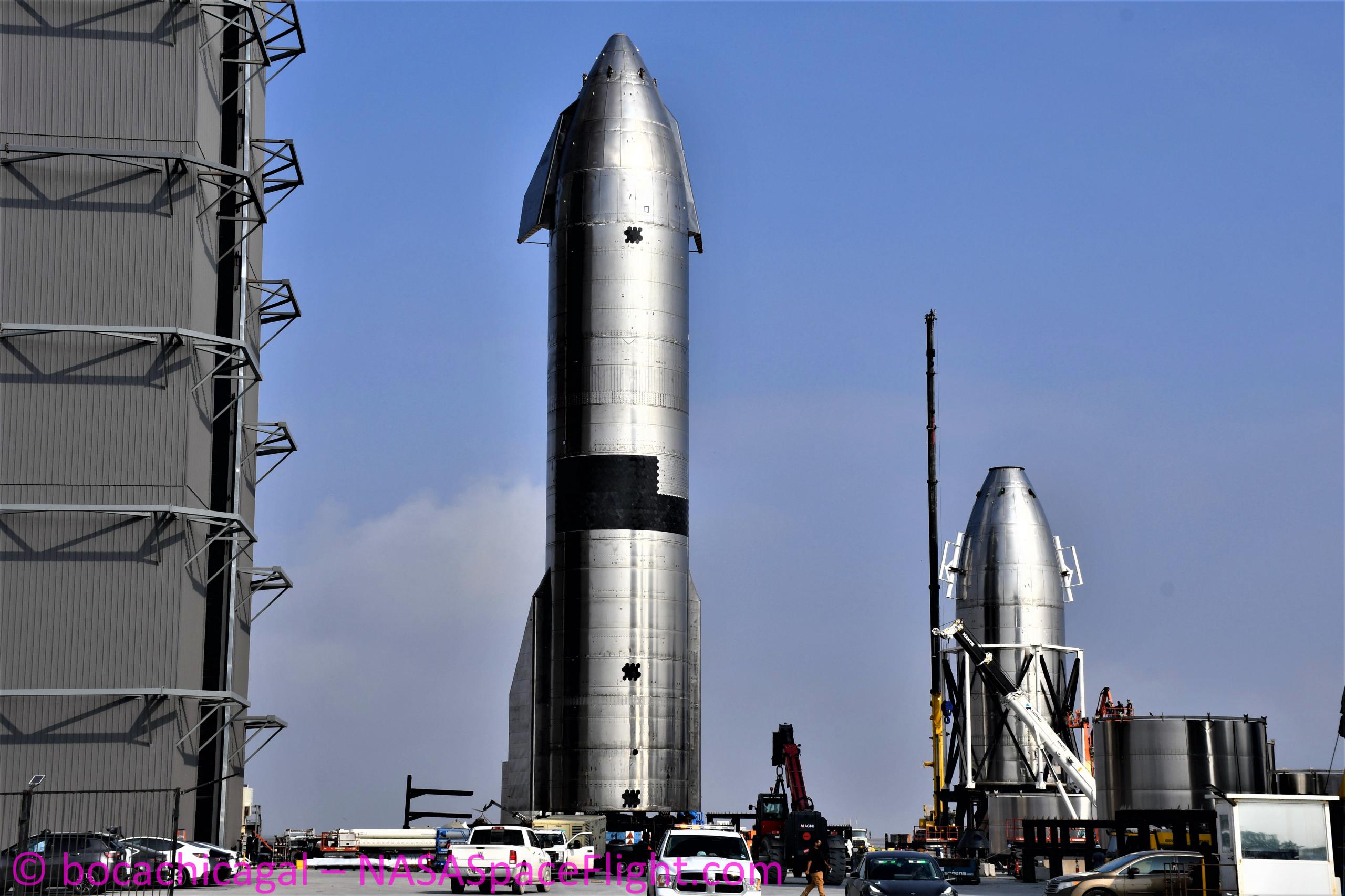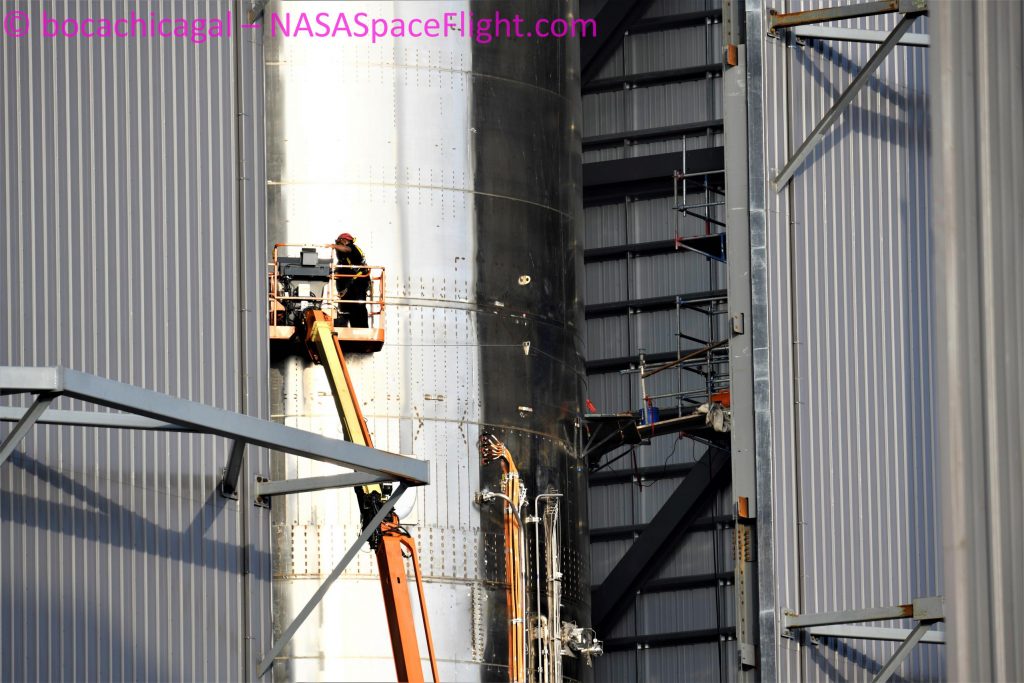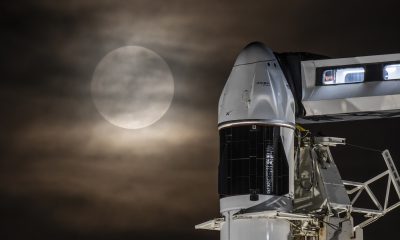

News
SpaceX rolls next Starship to the launch pad nine days after midair explosion
Update: Right on schedule, SpaceX has transported Starship serial number 15 (SN15) from its Boca Chica rocket factory to a launch and test site just down the road.
SN15’s pad arrival comes just nine days after Starship SN11 – the last in a batch of four first-generation prototypes – exploded in midair some 30 seconds before a planned landing. While minor, SN11’s midair failure was undoubtedly a step backward relative to Starship SN10, which (briefly) became the first full-size prototype to land in one piece less than a month prior. Both SN8, SN9, and SN10 made it further into their identical flight tests, leaving SN11 somewhat high and dry and putting extra pressure on Starship SN15.
After Starship SN8’s unexpectedly successful December 2020 test flight, in which the rocket made it just a dozen or so seconds away from soft landing after more than six minutes in flight, SpaceX made the decision to scrap Starship SN12 and kill SN13 and SN14 before assembly could begin. Effectively a gamble that SN8-SN11 would produce enough of a foundation for future testing to start off on, it’s hard to say if that gamble paid off.
All four Starship flights managed the extraordinary feat of more than four minutes of powered flight and spent two minutes free-falling like no rocket ever before them, but they also made it clear that both Raptor and autogenous pressurization (using gasified propellant to pressurize Starship’s tanks) are not quite mature enough for reliable launches and landings. Featuring “hundreds of improvements,” many of which were hopefully designed to tackle some of those shortcomings, it’ll be up to Starship SN15 to attempt to carry that torch forward – and, with any luck, further than any prototype before it.
After SpaceX unexpectedly used a Monday road closure to deliver its first custom-built rocket fuel tank, plans for the next Starship test campaign and launch have begun to solidify.
Most importantly, the initial schedule for Starship serial number 15’s (SN15) test campaign appears to be clear. As of Wednesday, April 7th, road closures filed by SpaceX suggest that the first of a new group of upgraded Starships will be transported from build site to launch pad as early as 11am-1:30pm CDT (UTC-5) on Thursday, April 8th. Once SN15 is installed on ‘Suborbital Pad A,’ SpaceX means to waste no time and has scheduled a 7am-12pm road closure on Friday.
As usual, the weekend will once again be free of any testing or activity requiring road closures, but SpaceX has already cordoned off noon to 8pm on Monday and Tuesday (April 12/13) to continue putting its newest Starship prototype to the test.

While road closure notices no longer offer any real detail, a few basic details can still be inferred. The April 7th closure, for example, warns that SpaceX only plans to intermittently close the highway but not Boca Chica Beach – implying that the window poses no threat to residents or beachgoers. Historically, that means that something will be transported – likely Starship SN15, in this case.
On Friday, SpaceX has scheduled a full five-hour closure of both the highway and beach, implying that some kind of testing is likely on the books. The same goes for Monday and Tuesday, but with longer eight-hour closures.
More likely than not, assuming Starship SN15’s pad transport and launch mount installation goes smoothly, SpaceX will use the shorter Friday window to complete a basic ambient pressure test – filling the rocket with ambient-temperature nitrogen gas to test its complex plumbing and propellant tanks for leaks. Continuing the IFF (if and only if) string, SpaceX will then spend the weekend preparing Starship SN15 for a cryogenic proof test and thrust structure stress test – simulating the thrust of three Raptors after loading the rocket with extremely cold liquid nitrogen (LN2).
SpaceX will then most likely spend another one or two days inspecting Starship SN15 and removing the hydraulic ram used to simulated thrust from the launch mount the ship is installed on. Once SN15 and its mount are cleared, SpaceX can move into static fire testing. Given that – according to CEO Elon Musk – SN15 will debut Raptor engines with an unknown degree of upgrades, it’s reasonable to assume that SpaceX will take things relatively slowly and possibly perform more than one static fire test even if the first attempt is a total success.
If not and SpaceX continues to push hard like it did with SN10 and SN11, it’s not out of the question that Starship SN15 will be ready for its first launch attempt around Friday, April 16th or Monday, April 19th. Stay tuned for updates as SpaceX hopefully rolls the rocket to its Boca Chica, Texas launch site later today.
Elon Musk
Tesla reveals it is using AI to make factories more sustainable: here’s how
Tesla is using AI in its Gigafactory Nevada factory to improve HVAC efficiency.

Tesla has revealed in its Extended Impact Report for 2024 that it is using Artificial Intelligence (AI) to enable its factories to be more sustainable. One example it used was its achievement of managing “the majority of the HVAC infrastructure at Gigafactory Nevada is now AI-controlled” last year.
In a commitment to becoming more efficient and making its production as eco-friendly as possible, Tesla has been working for years to find solutions to reduce energy consumption in its factories.
For example, in 2023, Tesla implemented optimization controls in the plastics and paint shops located at Gigafactory Texas, which increased the efficiency of natural gas consumption. Tesla plans to phase out natural gas use across its factories eventually, but for now, it prioritizes work to reduce emissions from that energy source specifically.
It also uses Hygrometric Control Logic for Air Handling Units at Giafactory Berlin, resulting in 17,000 MWh in energy savings each year. At Gigafactory Nevada, Tesla saves 9.5 GWh of energy through the use of N-Methylpyrrolidone refineries when extracting critical raw material.
Perhaps the most interesting way Tesla is conserving energy is through the use of AI at Gigafactory Nevada, as it describes its use of AI to reduce energy demand:
“In 2023, AI Control for HVAC was expanded from Nevada and Texas to now include our Berlin-Brandenburg and Fremont factories. AI Control policy enables HVAC systems within each factory to work together to process sensor data, model factory dynamics, and apply control actions that safely minimize the energy required to support production. In 2024, this system achieved two milestones: the majority of HVAC infrastructure at Gigafactory Nevada is now AI-controlled, reducing fan and thermal energy demand; and the AI algorithm was extended to manage entire chiller plants, creating a closed-loop control system that optimizes both chilled water consumption and the energy required for its generation, all while maintaining factory conditions.”
Tesla utilizes AI Control “primarily on systems that heat or cool critical factory production spaces and equipment.” AI Control communicates with the preexisting standard control logic of each system, and any issues can be resolved by quickly reverting back to standard control. There were none in 2024.
Tesla says that it is utilizing AI to drive impact at its factories, and it has proven to be a valuable tool in reducing energy consumption at one of its facilities.
Elon Musk
Tesla analysts believe Musk and Trump feud will pass
Tesla CEO Elon Musk and U.S. President Donald Trump’s feud shall pass, several bulls say.

Tesla analysts are breaking down the current feud between CEO Elon Musk and U.S. President Donald Trump, as the two continue to disagree on the “Big Beautiful Bill” and its impact on the country’s national debt.
Musk, who headed the Department of Government Efficiency (DOGE) under the Trump Administration, left his post in May. Soon thereafter, he and President Trump entered a very public and verbal disagreement, where things turned sour. They reconciled to an extent, and things seemed to be in the past.
However, the second disagreement between the two started on Monday, as Musk continued to push back on the “Big Beautiful Bill” that the Trump administration is attempting to sign into law. It would, by Musk’s estimation, increase spending and reverse the work DOGE did to trim the deficit.
Every member of Congress who campaigned on reducing government spending and then immediately voted for the biggest debt increase in history should hang their head in shame!
And they will lose their primary next year if it is the last thing I do on this Earth.
— Elon Musk (@elonmusk) June 30, 2025
President Trump has hinted that DOGE could be “the monster” that “eats Elon,” threatening to end the subsidies that SpaceX and Tesla receive. Musk has not been opposed to ending government subsidies for companies, including his own, as long as they are all abolished.
How Tesla could benefit from the ‘Big Beautiful Bill’ that axes EV subsidies
Despite this contentious back-and-forth between the two, analysts are sharing their opinions now, and a few of the more bullish Tesla observers are convinced that this feud will pass, Trump and Musk will resolve their differences as they have before, and things will return to normal.
ARK Invest’s Cathie Wood said this morning that the feud between Musk and Trump is another example of “this too shall pass:”
BREAKING: CATHIE WOOD SAYS — ELON AND TRUMP FEUD “WILL PASS” 👀 $TSLA
She remains bullish ! pic.twitter.com/w5rW2gfCkx
— TheSonOfWalkley (@TheSonOfWalkley) July 1, 2025
Additionally, Wedbush’s Dan Ives, in a note to investors this morning, said that the situation “will settle:”
“We believe this situation will settle and at the end of the day Musk needs Trump and Trump needs Musk given the AI Arms Race going on between the US and China. The jabs between Musk and Trump will continue as the Budget rolls through Congress but Tesla investors want Musk to focus on driving Tesla and stop this political angle…which has turned into a life of its own in a roller coaster ride since the November elections.”
Tesla shares are down about 5 percent at 3:10 p.m. on the East Coast.
Elon Musk
Tesla scrambles after Musk sidekick exit, CEO takes over sales
Tesla CEO Elon Musk is reportedly overseeing sales in North America and Europe, Bloomberg reports.

Tesla scrambled its executives around following the exit of CEO Elon Musk’s sidekick last week, Omead Afshar. Afshar was relieved of his duties as Head of Sales for both North America and Europe.
Bloomberg is reporting that Musk is now overseeing both regions for sales, according to sources familiar with the matter. Afshar left the company last week, likely due to slow sales in both markets, ending a seven-year term with the electric automaker.
Tesla’s Omead Afshar, known as Elon Musk’s right-hand man, leaves company: reports
Afshar was promoted to the role late last year as Musk was becoming more involved in the road to the White House with President Donald Trump.
Afshar, whose LinkedIn account stated he was working within the “Office of the CEO,” was known as Musk’s right-hand man for years.
Additionally, Tom Zhu, currently the Senior Vice President of Automotive at Tesla, will oversee sales in Asia, according to the report.
It is a scramble by Tesla to get the company’s proven executives over the pain points the automaker has found halfway through the year. Sales are looking to be close to the 1.8 million vehicles the company delivered in both of the past two years.
Tesla is pivoting to pay more attention to the struggling automotive sales that it has felt over the past six months. Although it is still performing well and is the best-selling EV maker by a long way, it is struggling to find growth despite redesigning its vehicles and launching new tech and improvements within them.
The company is also looking to focus more on its deployment of autonomous tech, especially as it recently launched its Robotaxi platform in Austin just over a week ago.
However, while this is the long-term catalyst for Tesla, sales still need some work, and it appears the company’s strategy is to put its biggest guns on its biggest problems.
-

 Elon Musk1 day ago
Elon Musk1 day agoTesla investors will be shocked by Jim Cramer’s latest assessment
-

 News6 days ago
News6 days agoTesla Robotaxi’s biggest challenge seems to be this one thing
-

 News2 weeks ago
News2 weeks agoTesla’s Grok integration will be more realistic with this cool feature
-

 Elon Musk2 weeks ago
Elon Musk2 weeks agoElon Musk slams Bloomberg’s shocking xAI cash burn claims
-

 News2 weeks ago
News2 weeks agoTesla China roars back with highest vehicle registrations this Q2 so far
-

 News2 weeks ago
News2 weeks agoTexas lawmakers urge Tesla to delay Austin robotaxi launch to September
-

 News2 weeks ago
News2 weeks agoTesla dominates Cars.com’s Made in America Index with clean sweep
-

 Elon Musk1 week ago
Elon Musk1 week agoFirst Look at Tesla’s Robotaxi App: features, design, and more




















